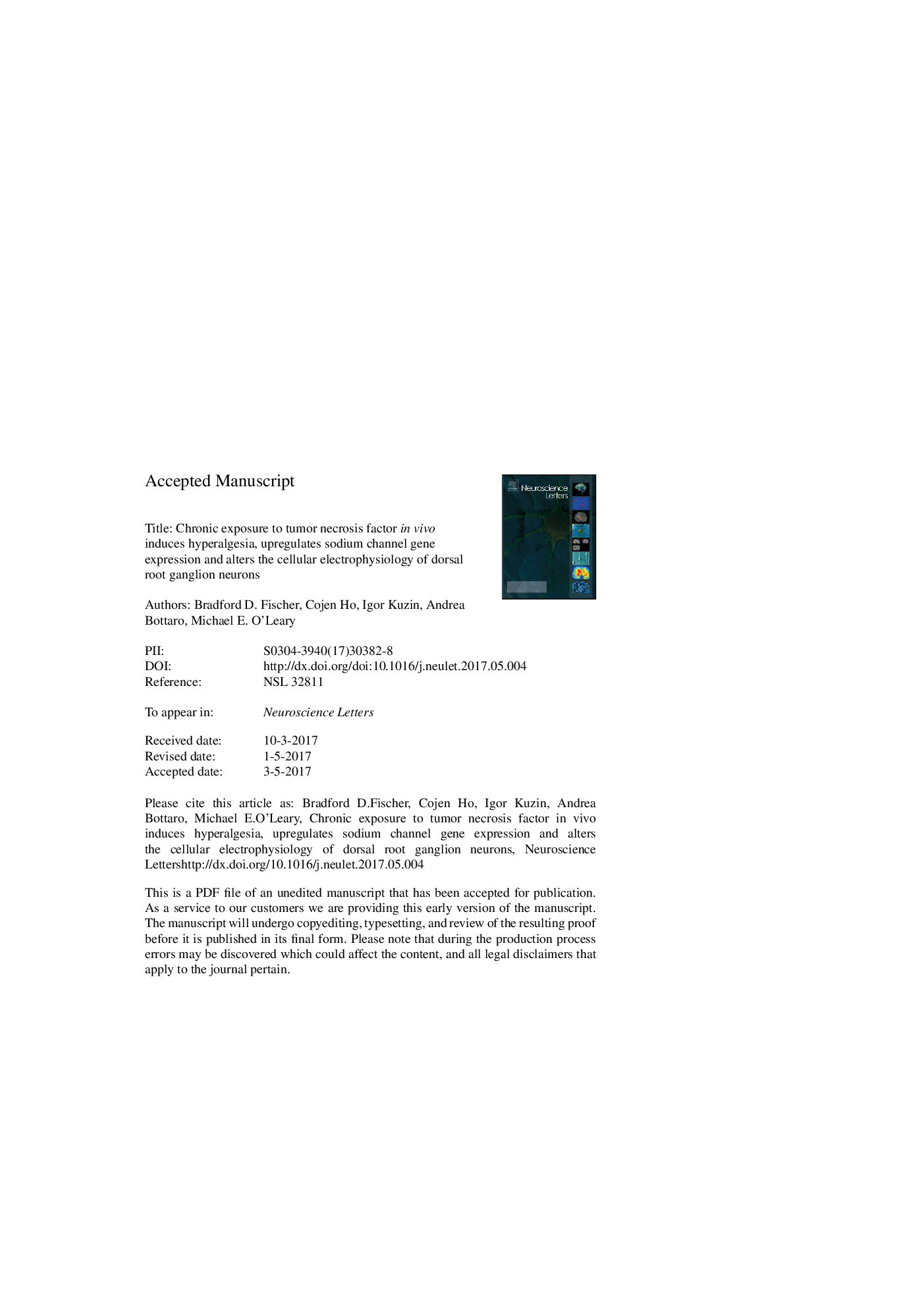| کد مقاله | کد نشریه | سال انتشار | مقاله انگلیسی | نسخه تمام متن |
|---|---|---|---|---|
| 5738130 | 1615046 | 2017 | 20 صفحه PDF | دانلود رایگان |
عنوان انگلیسی مقاله ISI
Chronic exposure to tumor necrosis factor in vivo induces hyperalgesia, upregulates sodium channel gene expression and alters the cellular electrophysiology of dorsal root ganglion neurons
دانلود مقاله + سفارش ترجمه
دانلود مقاله ISI انگلیسی
رایگان برای ایرانیان
کلمات کلیدی
موضوعات مرتبط
علوم زیستی و بیوفناوری
علم عصب شناسی
علوم اعصاب (عمومی)
پیش نمایش صفحه اول مقاله

چکیده انگلیسی
The goal of these studies was to investigate the links between chronic exposure to the pro-inflammatory cytokine tumor necrosis factor (TNF), hyperalgesia and the excitability of dorsal root ganglion (DRG) sensory neurons. We employed transgenic mice that constitutively express TNF (TNFtg mice), a well-established model of chronic systemic inflammation. At 6 months of age, TNFtg mice demonstrated increased sensitivity to both mechanical and thermal heat stimulation relative to aged-matched wild-type controls. These increases in stimulus-evoked behaviors are consistent with nociceptor sensitization to normal physiological stimulation. The mechanisms underlying nociceptor sensitization were investigated using single-cell analysis to quantitatively compare gene expression in small-diameter (<30 μm) DRG neurons. This analysis revealed the upregulation of mRNA encoding for tetrodotoxin-resistant (TTX-R) sodium (Na+) channels (Nav1.8, Nav1.9), Na+ channel β subunits (β1-β3), TNF receptor 1 (TNFR1) and p38α mitogen-activated protein kinase in neurons of TNFtg mice. Whole-cell electrophysiology demonstrated a corresponding increase in TTX-R Na+ current density, hyperpolarizing shifts in activation and steady-state inactivation, and slower recovery from inactivation in the TNFtg neurons. Increased overlap of activation and inactivation in the TNFtg neurons produces inward Na+ currents at voltages near the resting membrane potential of sensory neurons (i.e. window currents). The combination of increased Na+ current amplitude, hyperpolarized shifts in Na+ channel activation and increased window current predicts a reduction in the action potential threshold and increased firing of small-diameter DRG neurons. Together, these data suggest that increases in the expression of Nav1.8 channels, regulatory β1 subunits and TNFR1 contribute to increased nociceptor excitability and hyperalgesia in the TNFtg mice.
ناشر
Database: Elsevier - ScienceDirect (ساینس دایرکت)
Journal: Neuroscience Letters - Volume 653, 13 July 2017, Pages 195-201
Journal: Neuroscience Letters - Volume 653, 13 July 2017, Pages 195-201
نویسندگان
Bradford D. Fischer, Cojen Ho, Igor Kuzin, Andrea Bottaro, Michael E. O'Leary,